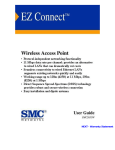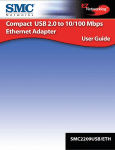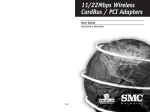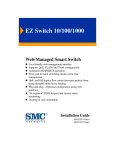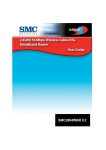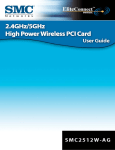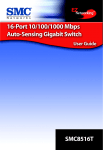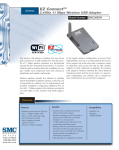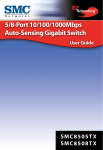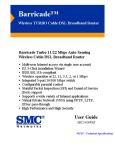Download SMC Networks SMC2835W User's Manual
Transcript
Copyright Information furnished by SMC Networks, Inc. (SMC) is believed to be accurate and reliable. However, no responsibility is assumed by SMC for its use, nor for any infringements of patents or other rights of third parties which may result from its use. No license is granted by implication or otherwise under any patent or patent rights of SMC. SMC reserves the right to change specifications at any time without notice. Copyright © 2003 by SMC Networks, Inc. 38 Tesla Irvine, California 92618 All rights reserved. Trademarks SMC is a registered trademark; and EZ Connect and EZ Hub are trademarks of SMC Networks, Inc. Other product and company names are trademarks or registered trademarks of their respective holders. Compliances FCC - Class B This equipment has been tested and found to comply with the limits for a Class B digital device, pursuant to Part 15 of the FCC Rules. These limits are designed to provide reasonable protection against harmful interference in a residential installation. This equipment generates, uses and can radiate radio frequency energy and, if not installed and used in accordance with instructions, may cause harmful interference to radio communications. However, there is no guarantee that the interference will not occur in a particular installation. If this equipment does cause harmful interference to radio or television reception, which can be determined by turning the equipment off and on, the user is encouraged to try to correct the interference by one or more of the following measures: • Reorient the receiving antenna • Increase the separation between the equipment and receiver • Connect the equipment into an outlet on a circuit different from that to which the receiver is connected • Consult the dealer or an experienced radio/TV technician for help FCC Caution: To assure continued compliance, (example - use only shielded interface cables when connecting to computer or peripheral devices). Any changes or modifications not expressly approved by the party responsible for compliance could void the user’s authority to operate this equipment. This device complies with Part 15 of the FCC Rules. Operation is subject to the following two conditions: (1) This device may not cause harmful interference, and (2) this device must accept any interference received, including interference that may cause undesired operation. CAUTION STATEMENT: FCC Radiation Exposure Statement This equipment complies with FCC radiation exposure limits set forth for an uncontrolled environment. This equipment should be installed and operated with a minimum distance of 5 centimeters between the radiator and your body. This transmitter must not be co-located or operating in conjunction with any other antenna or transmitter. Note: In order to maintain compliance with the limits of a Class B digital device, SMC requires that you use a quality interface cable when connecting to this device. Changes or modifications not expressly approved by SMC could void the user’s authority to operate this equipment. Attach unshielded twisted-pair cable (UTP) to the RJ-45 port and shielded USB cable to the USB port. Industry Canada - Class B This digital apparatus does not exceed the Class B limits for radio noise emissions from digital apparatus as set out in the interference-causing equipment standard entitled “Digital Apparatus,” ICES-003 of Industry Canada. Cet appareil numérique respecte les limites de bruits radioélectriques applicables aux appareils numériques de Classe B prescrites dans la norme sur le matérial brouilleur: “Appareils Numériques,” NMB-003 édictée par l’Industrie. 1 | System Requirements • Available 32-bit Cardbus PCMCIA Type II slot • Windows 98SE/Me/2000/XP • Minimum of 32MB RAM and 300 MHz CPU • Minimum of 1 MB available hard disk space for utility and driver installation • Another IEEE 802.11b or 802.11g compliant device installed in your network, such as the SMC2804WBR Barricade g 2.4GHz 54 Mbps Wireless Cable/DSL Broadband Router, or another PC with a wireless adapter, such as the SMC2662W EZ Connect 2.4GHz 11 Mbps Wireless USB Adapter. 2 | Package Contents After unpacking the EZ Connect g SMC2835W 2.4GHz 54 Mbps Wireless Cardbus Adapter, check the contents of the box to be sure you have received the following components: • 1 SMC2835W 2.4GHz 54 Mbps Wireless Cardbus Adapter • 1 EZ Installation Wizard and Documentation CD • 1 User Guide Immediately inform your dealer in the event of any incorrect, missing or damaged parts. If possible, please retain the carton and original packing materials in case there is a need to return the product. Please register this product and upgrade the product warranty at SMC's Web site: http://www.smc.com 3 | Getting Started… Warning: • Network cards are sensitive to static electricity. To protect the card, avoid touching its electrical components and always touch the metal chassis of your computer before handling the card 1. Turn on your computer and insert the EZ Installation Wizard and Documentation CD. Run the utility software and then reboot when requested. 2. Find an available Cardbus slot in your computer. 3. With the SMC2835W 2.4GHz 54 Mbps Wireless Cardbus Adapter's 68-pin connector facing the Cardbus slot, and the "EZ Connect g" label facing up, slide the card completely into the Cardbus slot as shown below: 4. For Windows 98/Me/2000, Cardbus specification is required. Please check the documents for your Cardbus adapter driver before installing the software driver for the SMC2835W. 5. The card will be automatically installed upon insertion. Once complete, you may take advantage of the wireless functionality this adapter has to offer. 4 | Driver Installation – Option 1 (Recommended) Windows 98SE/Me/2000/XP NOTE: Installation processes will require the use of your original, licensed copy of Windows. Please have your Windows CD available BEFORE proceeding with the installation. This installation method makes the process as simple and Plug-and-Play as possible. Simply run the EZ Installation Wizard, reboot your machine and insert your EZ Connect g SMC2835W 2.4GHz 54 Mbps Wireless Cardbus Adapter. It's as easy as 1-2-3. Step 1: Insert the EZ Installation Wizard and Documentation CD. Step 2: Click the [Install Driver] button. Step 3: Please shut down your machine and insert your SMC2835W. Once the Windows Operating System is booted up, it will find the new hardware and automatically install it. Section 4.1 | Other Setup Processes The following are Operating System-specific options that may appear during this installation procedure: Windows 98/Me: If you are using Windows 98, you must have your original Windows CD on hand. In Windows Me, the installation process is fully Plug-and-Play. Windows 2000/XP: Select [Install the software automatically] if prompted and click [Next] to complete the installation. Continue to the Utility Configuration section for documentation on how to use the utility application for your SMC2835W. 5 | Driver Installation – Option 2 Windows 98SE/Me/2000/XP Section 5.1 | Windows 98SE NOTE: Installation processes will require the use of your original, licensed copy of Windows. Please have your Windows CD available BEFORE proceeding with the installation. Step 1: After you have inserted the EZ Connect g SMC2835W 2.4GHz 54 Mbps Wireless Cardbus Adapter in your machine, the Operating System will automatically recognize the adapter and prompt you for the appropriate drivers. Click the [Next >] button to begin the installation. Step 2: Insert the Driver CD and select the [Search for the best driver for your device] option and click [Next >]. Step 3: Clear all checkboxes except for [Specify a location:]. Then press the [Browse] button and look for the drivers on your CD-ROM. Browse to ?:\driver. (Note: The "?" equals the letter of your CD-ROM drive. In most cases, this is D.) Step 4: The system should find the drivers. Click the [Next >] button to continue the installation. The wizard will show "SMC2835W 2.4GHz 54 Mbps Wireless Cardbus Adapter". (Note: If the system could not find the drivers, click the [< Back] button, and select the [Display a list of all the drivers...] option. Select [Network Adapters] from the list of devices, press [Have Disk] and once again browse to the location of the drivers) Step 5: Once the system has copied the SMC drivers from the CD, it may then request files from your original Windows disk. Please insert the Windows CD at this time. Step 6: The system will copy the files. Do NOT press [Cancel]. Step 7: Once all the necessary files are copied from the Windows CD, the driver install process will be complete. Click [Finish] to exit the wizard. Step 8: You will then be prompted to reboot the machine. Press [Yes]. Upon reboot, the SMC2835W Wireless Cardbus Adapter will be initialized and ready for use. Section 5.2 |Windows Me NOTE: Installation processes will require the use of your original, licensed copy of Windows. Please have your Windows CD available BEFORE proceeding with the installation. Step 1: After you have inserted the EZ Connect g SMC2835W 2.4GHz 54 Mbps Wireless Cardbus Adapter in your machine and turned it back on, the OS will automatically recognize the adapter and prompt you for the appropriate drivers. Select the [Specify the location of the driver] option. Then click the [Next >] button to begin the installation. Step 2: Insert the Driver CD and select the [Specify a location:] option. Clear the [Removable Media] checkbox. Then press the [Browse] button and look for the drivers on your CD. This should be located in ?:\driver. (Note: The ? equals the letter of your CD-ROM drive. In most cases, this is D.) Then click [Next >]. Step 3: The system should find the drivers. Click the [Next >] button to continue the installation. (Note: If the system could not find the drivers, click the [< Back] button, and select the [Display a list of all the drivers] option. Select [Network Adapters] from the list of devices, press [Have Disk] and once again browse to the location of the drivers) Step 4: Once all the necessary files have been copied, the driver installation is complete. Click [Finish] to exit the wizard. Step 5: You will then be prompted to reboot the machine. Press [Yes]. Upon reboot, the SMC2835W will be initialized and ready for use. Section 5.3 | Windows 2000 Step 1: After you have inserted the EZ Connect g SMC2835W 2.4GHz 54 Mbps Wireless Cardbus Adapter in your machine and turned it back on, the Operating System will automatically recognize the adapter and prompt you for the appropriate drivers. Click the [Next >] button to begin the installation. Step 2: Insert the Driver CD and select the [Search for a suitable driver...] option. Then click [Next >]. Step 3: Clear all checkboxes except for [Specify a location]. Then click [Next >]. Step 4: You will then be prompted to enter the location of the drivers. This should be ?:\driver. (Note: The ? equals the letter of your CD-ROM drive. In most cases, this is D.) Then click [OK]. You can also click [Browse] and browse to the location of the drivers on the CD for further verification. Step 5: The system should find the drivers. Click the [Next >] button to continue the installation. (Note: If the system could not find the drivers, click the [< Back] button, and select the [Display a list of the known drivers...] option. Select [Network Adapters] from the list of devices, press [Have Disk] and once again browse to the location of the drivers) Step 6: You have now completed the driver installation. Click [Finish] to initialize the adapter. Section 5.4 | Windows XP Step 1: After you have inserted the EZ Connect g SMC2835W 2.4GHz 54 Mbps Wireless Cardbus Adapter in your machine and turned it back on, the Operating System will automatically recognize the adapter and prompt you for the appropriate drivers. Select [Install from a list or specific location] and click the [Next >] button to begin the installation. Step 2: Insert the Driver CD and check the [Include this location in the search] option. Make sure the [Search removable media] option is not checked. Click [Browse] and find the location of the drivers. This should be ?:\driver. (Note: The ? equals the letter of your CD-ROM drive. In most cases, this is D.) Then click [Next >]. Step 3: This process will be completed once the drivers are copied to the hard drive and installed. Please click [Finish] to exit the wizard. After clicking [Finish], you will see the following message in your system tray: 6 | Driver Verification Windows 98SE/Me/2000/XP Section 6.1 | Windows 98/Me Step 1: Right-click the My Computer icon on your desktop and click [Properties]. Step 2: Then go to the [Device Manager] tab and open the [Network adapters] section. You should see your SMC2835W 2.4GHz 54 Mbps Wireless Cardbus Adapter in this menu. Highlight it and click [Properties]. Step 3: The Device Status shows that the "This device is working properly". If there are any error messages displayed here, you will need to click the SMC adapter and click [Remove]. Then reboot the machine and go through the installation process again. Section 6.2 | Windows 2000 Step 1: Right-click the My Computer icon on your desktop and click [Properties]. Step 2: Then go to the Hardware tab and click [Device Manager]. Open the [Network adapters] section. You should see your SMC2835W 2.4GHz 54 Mbps Wireless Cardbus Adapter in this menu. Right-click your adapter and click [Properties]. Step 3: The Device Status shows that the "This device is working properly". If there are any error messages displayed here, you will need to right-click the SMC adapter and click [Uninstall]. Then reboot the machine and go through the installation process again. Section 6.3 | Windows XP Step 1: Click [Start] and click [Control Panel]. Then click the [Performance and Maintenance] icon and select [System]. Step 2: Then go to the Hardware tab and click [Device Manager]. Open the [Network adapters] section. You should see your SMC2835W 2.4GHz 54 Mbps Wireless Cardbus Adapter in this menu. Right-click the adapter and click [Properties]. Step 3: The Device Status shows that "This device is working properly". If there are any error messages displayed here, you will need to right-click the SMC adapter and click [Uninstall]. Then reboot the machine and go through the installation process again. 7 | Utility Installation Windows 98SE/Me/2000/XP This Installation method makes the process as simple and Plug-and-Play as possible. Simply run the EZ Installation Wizard, reboot your machine and insert your EZ Connect g SMC2835W 2.4GHz 54 Mbps Wireless Cardbus Adapter. It's as easy as 1-2-3. Step 1: Insert the EZ Installation Wizard and Documentation CD. Step 2: Click the [Install Utility] button. Step 3: The installation wizard will begin. Click [Next >]. Step 4: You will be given the option to choose the location where the Configuration Utility will be installed. It is recommended to leave this at the default value. Click [Next >] to continue. You will also be given the option to choose the Folder name that will appear in the Start Menu. It is recommended to leave this at the default value. Click [Next >] to continue. Step 5: Click [Next] to begin copying the utility files to your computer. You have now completed the utility installation process. Click [Finish] to exit the wizard. Step 6: Please shut down your machine. Then insert your SMC2835W and boot up the operating system. 8 | Utility Configuration When the utility program is running, there will be a quick launch icon in the lower right-hand corner of the taskbar. The icon will be GREEN if you have a good connection to a wireless network. If it is red, you will need to verify the network settings and check to be sure that the Wireless Access Point on your network is turned on. You may also need to re-position the Access Point and place it in a higher position so that you are able to gain more wireless signal strength. Double-click the quick launch icon in the system tray to bring up the Configuration Utility. This provides quick access to management statistics and adapter settings. The Configuration Utility includes the following tabs: Configuration: Allows you to implement Profile Management, edit SSID data, change the Tx Rate and Operating mode, and enable 64/128-bit WEP. Link Information: Allows you to view/monitor network status, throughput, wireless channel, and TCP/IP Information. IP Information: Displays TCP/IP data and allows you to Release and Renew your IP addresses. Site Survey: Displays all the Access Points within range of the wireless adapter's signal. Allows you to select your desired WLAN. Version Information: Shows the driver and utility version information. Section 8.1 | Configuration When the Configuration Utility is initialized, the Configuration window may be immediately shown. This will show you the current select profile of the wireless card. Click [New] to enter a new name for the current profile. Click [Save] to save the current settings to the selected profile. Click [Delete] to delete the current profile. The options for Operating Mode are "802.11 Adhoc" and "Infrastructure". Adhoc networks consist of wireless clients only. In Infrastructure networks, wireless clients connect to wired LANs via Wireless Access Points. The options for Transmit Rate are "Auto", "1 Mbps", "2 Mbps", "5.5 Mbps", and "11 Mbps" for 802.11b networks. The options for Transmit Rate are "Auto", "1 Mbps", "2 Mbps", "5.5 Mbps", "11 Mbps", "6 Mbps", "9 Mbps", "12 Mbps", "18 Mbps", "24 Mbps", "36 Mbps", "48 Mbps", and "54 Mbps" for 802.11g networks. The Channel can only be changed when you are connected to a Adhoc WLAN. The channel must be configured to the same radio channel as that used by the other wireless clients in your group. For more secure data transmissions, it is recommended to enable WEP on your WLAN. The utility supports HEX key entries. For the HEX Key Format, the security is enabled by entering 10-digit keys for the 64-bit WEP configuration, and 26-digit keys for a 128-bit WEP configuration. Allowed hex keys are 0-9, A-F and a-f. Select the desired encryption strength (64-bit or 128-bit) and then enter the appropriate keys in Key 1, 2, 3, or 4. Remember to select the correct "Default Key" and then click [Apply Changes]. You can also check the "Passphrase" option and enter the desired value. You must be sure to use the same passphrase on all other wireless clients/Access Points. A passphrase string can consist of up to 32 alphanumberic characters. Section 8.2 | Link Information Associated BSS ID: Shows the MAC Address of the associated Access Point Current Tx Rate: Current transmit rate value Throughput: Number of packets sent and received SSID: Workgroup name of the wireless network that you are connected to Link Quality: Shows the relative link quality (e.g., lack of frame errors) of the wireless connection to the Access Point. Signal Strength: Shows the relative signal strength of the wireless connection to the Access Point. Section 8.3 | IP Information The IP Information screen displays network connection information. Section 8.4 | Site Survey The Site Survey tab scans and displays all Access Points on the wireless LAN. The data is organized by columns signifying the "SSID", "BSSID", "Channel", "Encryption", "Signal", and "Network Type". The key symbol in the Encryption column signifies that the network is encrypted. You will need to obtain the WEP information from the network administrator. To choose a network, simply double-click the "SSID". Section 8.5 | Version Information The Version Information screen displays the version information. 9 | Disable Wireless Zero Configuration in Windows XP It is recommended that you use the SMC2835W Configuration Utility to manage your 54 Mbps Wireless Cardbus Adapter. If you are using the SMC utility in Windows XP, you will need to disable the Wireless Zero Configuration. Follow the instructions below. Go to [Control Panel] and open [Network Connections]. Right-click the [Wireless Network Connection], and select [Properties]. Select the "Wireless Networks" tab and uncheck the [Use Windows to configure my wireless network settings] check box. 10 | SMC Networks EZ Connect g Wireless Cardbus Adapter Maximum Distance Table Important Notice Maximum distances posted below are actual tested distance thresholds. However, there are many variables such as barrier composition and construction, as well as local environmental interference that may impact your actual distances and cause you to experience distance thresholds far lower than those posted below. If you have any questions or comments regarding the features or performance of this product, or if you would like information regarding our full line of wireless products, you can visit us at www.smc.com, or you can call us toll-free at 800.SMC.4YOU. SMC Networks stands behind every product sold with a 30-day satisfaction guarantee and a limited-lifetime warranty. 802.11g Wireless Distance Table Environmental Condition Speed and Distance Ranges 54 Mbps 48 Mbps 36 Mbps 24 Mbps 18 Mbps 12 Mbps 6-9 Mbps Outdoors: A lineof-sight environment with no 60 m 90 m 150 m 190 m 220 m 270 m 350m interference or (197 ft) (295 ft) (492 ft) (623 ft) (722 ft) (886 ft) (1155 ft) obstruction between the Access Point and users. Indoors: A typical office or home environment with 40 m 50 m 60 m 65 m 70 m 110 m 180 m floor to ceiling (131 ft) (164 ft) (197 ft) (213 ft) (230 ft) (361 ft) (591 ft) obstructions between the Access Point and users. 802.11b Wireless Distance Table Environmental Condition Outdoors: A lineof-sight environment with no interference or obstruction between the Access Point and users. Indoors: A typical office or home environment with floor to ceiling obstructions between the Access Point and users. Speed and Distance Ranges 11 Mbps 5.5 Mbps 1-2 Mbps 190 m (623 ft) 240 m (787 ft) 350 m (1155 ft) 60 m (197 ft) 100 m (328 ft) 180 m (591 ft) 11 | Troubleshooting Common Installation Problems Problems are often caused by conflicts with other devices installed in the same computer, or software that has been configured incorrectly. If you encounter a problem with the EZ Connect g SMC2835W 2.4GHz 54 Mbps Wireless Cardbus Adapter, use the following checklists to identify and correct the problem. • If your computer cannot find the Wireless Card, or the network driver does not install correctly, check the following items before contacting SMC Technical Support o Make sure the card is securely seated in the PCMCIA. Check for any hardware problems, such as physical damage to the card. o Try the card in another PCMCIA. If this fails, test the card in a completely different system or try using a second Wireless Card in that particular slot. o Check for resource conflicts o Make sure your computer is using the latest BIOS available. Contact the manufacturer of the laptop, motherboard for information on updating the BIOS (e.g. – Dell, Toshiba, etc) o If there are other network cards in the computer, they may be causing conflicts. Remove all other cards from the computer and test the Wireless Card separately. Network Connection Problems There may be a network connection problem if the LED on the card does not light, or if you cannot access any network resources from the computer. Check the following items before contacting SMC Technical Support. • • • • • Make sure the correct network card driver is installed for your operating system. If necessary, try uninstalling and reinstalling the driver. To do this, first shut down your machine and remove your SMC adapter. Then boot up and open up your Start Menu, go to Programs, click the "SMC2835W 54 Mbps WLAN Utility" program folder and choose "Uninstall". Reboot the machine when requested to do so. Then insert your Driver CD and run the Setup.exe utility again. Then shut down the computer, reinsert your SMC adapter and boot up the machine. The OS should properly reinstall the adapter during this time. Make sure the computer and other network devices are receiving power. If you suspect a power outlet to be faulty, plug another device into it to verify that it is working. If your wireless station cannot communicate with a computer on the Ethernet LAN when configured for Infrastructure mode, try changing the wireless channel on the AP. Make sure the SSID is the same as that used by the AP for a station with roaming disabled, or the same as that used by the AP's in the extended service set (ESS). The Access Point you are trying to attach to is defective or may not be configured properly to accept your signal. Check with the administrator of your wireless network for more information on connecting to the LAN. Also run the necessary diagnostics on the AP to make sure the unit is fully operational. If you cannot access the Internet, be sure to check with the ISP for further instructions once the drivers for the Wireless Card are installed properly. 12 | Technical Specifications Standards: IEEE 802.11b and 802.11g-draft compliant Wireless Data Rates (With Automatic Fall-back): 802.11b = 1/2/5.5/11 Mbps 802.11g-draft = 1/2/5.5/6/9/11/12/18/24/36/48/54 Mbps Data Modulation Techniques: 802.11b (DSSS) = DBPSK, DQPSK, CCK 802.11g (OFDM) = BPSK, QPSK, 16-QAM, 64-QAM Host Interface: 32-bit Cardbus interface Operating Range: Up to 1,155 ft Network Configuration: Ad-Hoc (Peer-to-Peer) Infrastructure Radio Signal Type: Direct Sequence Spread Spectrum (DSSS) Orthogonal Frequency Division Multiplexing (OFDM) Media Access Protocol: CSMA/CA (Collision Avoidance) with ACK architecture 32-bit MAC Security: 64/128-bit Wired Equivalent Privacy (WEP) 802.1x* WPA (WiFi Protected Access)** Channel Support (2.4GHz RF): FCC - 1-11 ETSI - 1-13 TELEC - 1-14 RF Output Power: 17 dBm Operating Systems: Windows 98SE/Me/2000/XP Antenna Type: Built-in LED Indicators: Activity (ACT) Network Link (LINK) Power Voltage: 3.3 Volt + 5% Power Consumption: Transmission mode - 480mA Receive mode - 380mA Dimensions: 118.6 x 54.0 x 4.85 mm (LxWxH) Compliance: USA: FCC Part 15 Class B Europe: CE-Mark Industry Canada IEC 60950 WiFi Compliant Temperature Range: Operating: -0 C - +55 C Storage: -20 C - +65 C Humidity (non-condensing): 5-95% * Currently Available in Windows 2000 & XP ** Available via software upgrade in Spring 2003 13 | Frequently Asked Questions What is a Wireless LAN? A local area network that transmits over the air typically in an unlicensed frequency such as the 2.4GHz band. A wireless LAN does not require lining up devices for line of sight transmission like IrDA. Wireless access points (base stations) are connected to an Ethernet hub or server and transmit a radio frequency over an area of several hundred to a thousand feet which can penetrate walls and other non-metal barriers. Roaming users can be handed off from one access point to another like a cellular phone system. Laptops use wireless network cards that plug into an existing PCMCIA slot or that are self contained on PC cards, while stand-alone desktops and servers use plug-in cards (ISA, PCI, etc.). What is AD-HOC? An AD-HOC network is a peer to peer network where all the nodes are wireless clients. As an example, two PC’s with wireless adapters can communicate with each other as long as they are within range. A wireless extension point can extend the range of an AD-HOC network. What is the 802.11 standard? A family of IEEE standards for wireless LANs first introduced in 1997. 802.11 provides 1 or 2 Mbps transmission in the 2.4GHz band using either a frequency hopping modulation (FHSS) technique or direct sequence spread spectrum (DSSS), which is also known as CDMA. The 802.11b standard defines an 11 Mbps data rate in the 2.4GHz band, 802.11g-draft standard defines 54 Mbps in the 2.4GHz band, and the 802.11a standard defines 54 Mbps in the 5GHz band. What is Infrastructure? In order for your wireless components to interact with traditional wired networks they need a media bridge to translate for them. This is where INFRASTRUCTURE or Network mode comes into play. An ACCESS POINT is attached to the network using CAT-5 Ethernet cable attaching to a hub, switch or another PC. Wireless PC’s can then communicate to Wired Ethernet computers through this access point. The total range of the network is limited to a radius around this Access Point. To increase the range, extra Access Points may be wired into the network. These Access Points talk to each other over the hard-wired Ethernet cables however, they cannot communicate wirelessly to one another and they must be wired to the same network. Individual wireless PC’s can move between Access Points on the same network seamlessly due to a feature called ROAMING. What is Tx Rate? Tx-Rate or TRANSFER RATE is the current speed at which the network component is operating. SMC-802.11b products can operate at speeds of 1Mb, 2Mb, 5.5Mb, & 11Mbps. A wireless card set to AUTO will attempt to connect at whatever speed will give the best throughput on the network. What is RTS Threshold? (Request To Send) An RS-232 signal sent from the transmitting station to the receiving station requesting permission to transmit. RTS is a collision avoidance method used by all 802.11b wireless networking devices. In most cases you will not need to activate or administer RTS. Only if you find yourself in an Infrastructure environment where all nodes are in range of the Access Point but may be out of range of each other. It is recommended to leave this setting at its default value leaving this feature disabled. What is Authentication Algorithm? Authentication Algorithm is the means by which one station is authorized to communicate with another. In an Open System, any station can request authorization in accordance with the WECA standard. In a Shared key system, only stations that possess a secret encrypted key may participate in the network. This is a low level security key which allows the equipment with the shared key algorithm to see each other on the wireless lan. What is DBI? The ability of the antenna to shape the signal and focus it in a particular direction is called Antenna Gain, and is expressed in terms of how much stronger the signal in the desired direction is, compared to the worst possible antenna, which distributes the signal evenly in all directions (an Isotropic Radiator). To express the relationship to the Isotropic reference, this is abbreviated: "dBi". The typical omni-directional "stick" antenna is rated at 6-8 dBi, indicating that that by redirecting the signal that would have gone straight up or down to the horizontal level, 4 times as much signal is available horizontally. A parabolic reflector design can easily achieve 24 dBi. What is WEP? Short for Wired Equivalent Privacy, WEP is a security protocol for wireless local area networks (WLANs) defined in the 802.11b and 802.11a standards. WEP is designed to provide the same level of security as that of a wired LAN. LANs are inherently more secure than WLANs because LANs are somewhat protected by the physicalities of their structure, having some or all part of the network inside a building that can be protected from unauthorized access. WLANs, which are over radio waves, do not have the same physical structure and therefore are more vulnerable to tampering. WEP aims to provide security by encrypting data over radio waves so that it is protected as it is transmitted from one end point to another. The Wired Equivalent Privacy (WEP) feature uses the RC4 PRNG algorithm developed by RSA Data Security, Inc. If your wireless access point supports MAC filtering, it is recommended that you use this feature in addition to WEP (MAC filtering is much more secure than encryption). 14 | Terminology 10BaseT - Physical Layer Specification for Twisted-Pair Ethernet using Unshielded Twisted Pair wire at 10Mbps. This is the most popular type of LAN cable used today because it is very cheap and easy to install. It uses RJ-45 connectors and has a cable length span of up to 100 meters. There are two versions, STP (Shielded Twisted Pair) which is more expensive and UTP (Unshielded Twisted Pair), the most popular cable. These cables come in 5 different categories. However, only 3 are normally used in LANs, Category 3, 4 and 5. CAT 3 TP (Twisted Pair) cable has a network data transfer rate of up to 10Mbps. CAT 4 TP cable has a network data transfer rate of up to 16Mbps. CAT 5 TP cable has a network data transfer rate of up to 100Mbps. Access Point - A device that is able to receive wireless signals and transmit them to the wired network, and vice versa - thereby creating a connection between the wireless and wired networks. Ad Hoc - An ad hoc wireless LAN is a group of computers, each with LAN adapters, connected as an independent wireless LAN. Adapter - A device used to connect end-user nodes to the network; each contains an interface to a specific type of computer or system bus, e.g. EISA, ISA, PCI, PCMCIA, CardBus, etc. Auto-Negotiation - A signaling method that allows each node to define its operational mode (e.g., 10/100 Mbps and half/full duplex) and to detect the operational mode of the adjacent node. Backbone - The core infrastructure of a network. The portion of the network that transports information from one central location to another central location where it is unloaded onto a local system. Base Station - In mobile telecommunications, a base station is the central radio transmitter/receiver that maintains communications with the mobile radiotelephone sets within its range. In cellular and personal communications applications, each cell or micro-cell has its own base station; each base station in turn is interconnected with other cells' bases. BSS - BSS stands for "Basic Service Set". It is an Access Point and all the LAN PCs that are associated with it. CSMA/CA - Carrier Sense Multiple Access with Collision Avoidance DHCP - Dynamic Host Configuration Protocol. This protocol automatically configures the TCP/IP settings of every computer on your home network. DNS - DNS stands for Domain Name System, which allows Internet host computers to have a domain name (such as www.smc.com) and one or more IP addresses (such as 192.34.45.8). A DNS server keeps a database of host computers and their respective domain names and IP addresses, so that when a domain name is requested (as in typing " www.smc.com" into your Internet browser), the user is sent to the proper IP address. The DNS server address used by the computers on your home network is the location of the DNS server your ISP has assigned. DSL - DSL stands for Digital Subscriber Line. A DSL modem uses your existing phone lines to transmit data at high speeds. Ethernet - A standard for computer networks. Ethernet networks are connected by special cables and hubs, and move data around at up to 10 million bits per second (Mbps). ESS - ESS (ESS-ID, SSID) stands for "Extended Service Set". More than one BSS is configured to become an Extended Service Set. LAN mobile users can roam between different BSSs in an ESS (ESS-ID, SSID). Fast Ethernet NIC - Network interface card that is in compliance with the IEEE 802.3u standard. This card functions at the media access control (MAC) layer, using carrier sense multiple access with collision detection (CSMA/CD). Fixed IP – (see Static IP) Full-Duplex - Transmitting and receiving data simultaneously. In pure digital networks, this is achieved with two pairs of wires. In analog networks, or digital networks using carriers, it is achieved by dividing the bandwidth of the line into two frequencies, one for sending, one for receiving. Hub - Central connection device for shared media in a star topology. It may add nothing to the transmission (passive hub) or may contain electronics that regenerate signals to boost strength as well as monitor activity (active/intelligent hub). Hubs may be added to bus topologies; for example, a hub can turn an Ethernet network into a star topology to improve troubleshooting. IP Address - IP stands for Internet Protocol. An IP address consists of a series of four numbers separated by periods, that identifies an single, unique Internet computer host. Example: 192.34.45.8. ISP - Internet Service Provider. An ISP is a business that provides connectivity to the Internet for individuals and other businesses or organizations. LAN - A communications network that serves users within a confined geographical area. It is made up of servers, workstations, a network operating system and a communications link. Servers are high-speed machines that hold programs and data shared by network users. The workstations (clients) are the users' personal computers, which perform stand-alone processing and access the network servers as required. Diskless and floppy-only workstations are sometimes used, which retrieve all software and data from the server. Increasingly, "thin client" network computers (NCs) and Windows terminals are also used. A printer can be attached locally to a workstation or to a server and be shared by network users. Small LANs can allow certain workstations to function as a server, allowing users access to data on another user's machine. These peer-to-peer networks are often simpler to install and manage, but dedicated servers provide better performance and can handle higher transaction volume. Multiple servers are used in large networks. MAC Address - MAC (Media Access Control) A MAC address is the hardware address of a device connected to a network. MDI / MDI-X - Medium Dependent Interface - Also called an "uplink port," it is a port on a network hub or switch used to connect to other hubs or switches without requiring a crossover cable. The MDI port does not cross the transmit and receive lines, which is done by the regular ports (MDI-X ports) that connect to end stations. The MDI port connects to the MDI-X port on the other device. There are typically one or two ports on a device that can be toggled between MDI (not crossed) and MDI-X (crossed). Medium Dependent Interface – X (crossed) - A port on a network hub or switch that crosses the transmit lines coming in to the receive lines going out. NAT – (Network Address Translation) This process allows all of the computers on your home network to use one IP address. The NAT capability of the Barricade, allows you to access the Internet from any computer on your home network without having to purchase more IP addresses from your ISP. Network Address Translation can be used to give multiple users access to the Internet with a single user account, or to map the local address for an IP server (such as Web or FTP) to a public address. This secures your network from direct attack by hackers, and provides more flexible management by allowing you to change internal IP addresses without affecting outside access to your network. NAT must be enabled to provide multi-user access to the Internet or to use the Virtual Server function. Packet Binary Convulational Code(tm) (PBCC) - A modulation technique developed by Texas Instruments Inc. (TI) that offers data rates of up to 22Mbit/s and is fully backward compatible with existing 802.11b wireless networks. PCI - Peripheral Component Interconnect - Local bus for PCs from Intel that provides a highspeed data path between the CPU and up to 10 peripherals (video, disk, network, etc.). The PCI bus runs at 33MHz, supports 32-bit and 64-bit data paths, and bus mastering. PPPoE - Point-to-Point Protocol over Ethernet. Point-to-Point Protocol is a method of secure data transmission originally created for dial-up connections. PPPoE is for Ethernet connections. Roaming - A function that allows your to move through a particular domain without losing network connectivity. Static IP - If your Service Provider has assigned a fixed IP address; enter the assigned IP address, subnet mask and the gateway address provided by your service provider. Subnet Mask - A subnet mask, which may be a part of the TCP/IP information provided by your ISP, is a set of four numbers configured like an IP address. It is used to create IP address numbers used only within a particular network (as opposed to valid IP address numbers recognized by the Internet. TCP/IP - Transmission Control Protocol/Internet Protocol. This is the standard protocol for data transmission over the Internet. TCP - Transmission Control Protocol - TCP and UDP (User Datagram Protocol) are the two transport protocols in TCP/IP. TCP ensures that a message is sent accurately and in its entirety. However, for real-time voice and video, there is really no time or reason to correct errors, and UDP is used instead. UDP - User Datagram Protocol - A protocol within the TCP/IP protocol suite that is used in place of TCP when a reliable delivery is not required. For example, UDP is used for real-time audio and video traffic where lost packets are simply ignored, because there is no time to retransmit. If UDP is used and a reliable delivery is required, packet sequence checking and error notification must be written into the applications.

































